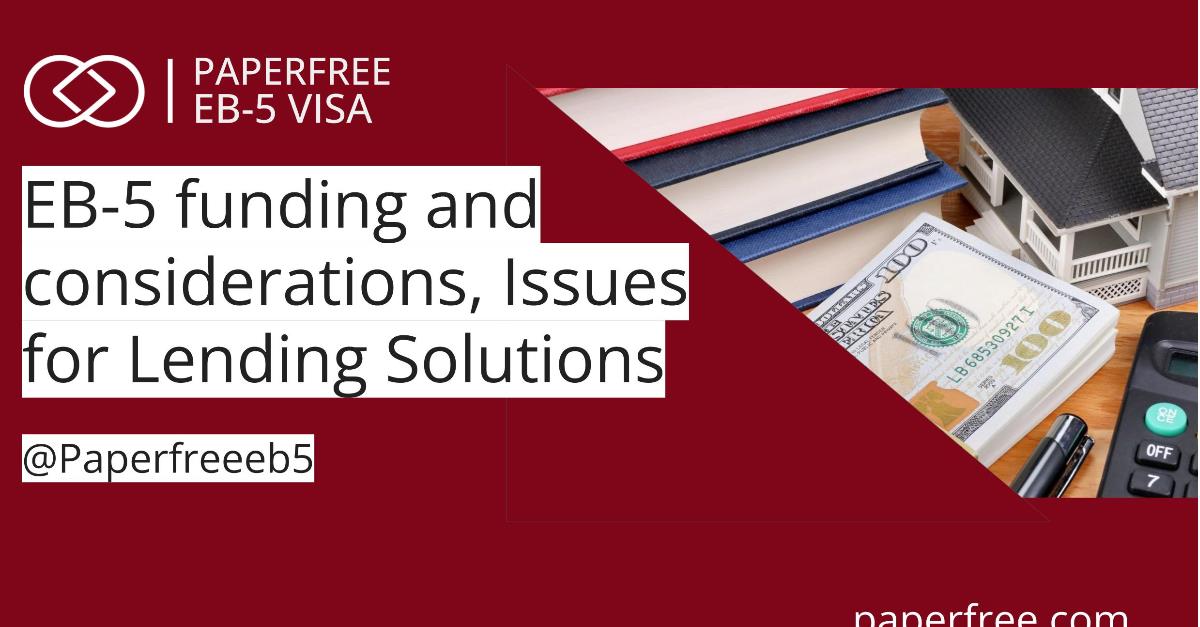PAPERFREE
investment visa
FREE CONSULTATION
EB-5 Funding 3.0: Considerations and Challenges of Formulating U.S.-based Lending Solutions for EB-5 Investors.
Dive into the evolution of EB-5 funding with a comprehensive exploration of the considerations and challenges involved in developing U.S.-based lending solutions tailored for EB-5 investors and emerging opportunities.last updated Friday, April 11, 2025
#eb-5 funding 3.0 #eb 5 funding
| | by Sidra Jabeen |

QUICK LINKS
AD
Get Access to EB 5 Visa Investment Projects
Key Takeaway:
- Emerging Paradox in EB-5 Industry
Investors are keen to participate after the program re-emerges but need help with increased investment amounts, liquidity issues, and currency restrictions. - Innovative Solution - U.S. Lenders for EB-5
Regional Centers and issuers are exploring creating U.S. lenders to issue loans to EB-5 investors directly. - Legal Drivers
Zhang v. USCIS landmark decision emphasizes that cash invested is not indebtedness, supporting the concept of U.S.-based lending.
The 2022 EB-5 Reform & Integrity Act (RIA) further supports the legitimacy of U.S.-based lending to EB-5 investors. - Challenges Faced by EB-5 Investors
Increased investment amounting to $800,000 poses challenges.
Both domestic and overseas investors need help with issues like currency restrictions and difficulty obtaining alternative loans. - Considerations for U.S.-Based EB-5 Lending Programs
Defining underlying goals, identifying target markets, and addressing legal, compliance, and business risks are crucial for creating effective U.S.-based lending programs.
What is EB Funding 3.0?
There isn't a universally accepted definition for "EB-5 funding 3.0". The term is relatively new and still evolving, with various interpretations and potential applications.

However, based on my understanding of the EB-5 program and recent developments, here are a few possible interpretations:
1. EB 5 Lending Solutions
One potential interpretation of "EB-5 funding 3.0" emphasizes facilitating EB-5 investments through U.S.-based lending programs. This approach addresses a growing demand from investors seeking financing options to participate in the program.
Several factors have contributed to this demand growth:
- Increased investment minimums
The minimum investment amount for the EB-5 program has increased from $500,000 to $800,000 (or $1,050,000 in Targeted Employment Areas), making it challenging for some investors to participate without external financing. - Stricter source of funds requirements
Investor funds have become more scrutinized, making it difficult for some to demonstrate the lawful origin of their capital. - Rise of regional center instability
Concerns about the stability of some regional centers have prompted investors to seek alternative investment options.
U.S.-based EB5 lending programs can help address these challenges by providing qualified investors with loans to cover their EB-5 investment amount. This can make the program more accessible and attractive to a broader pool of potential participants.
2. Incorporation of Blockchain Technology
Another potential interpretation of "Eb-5 funding 3.0" is integrating blockchain technology into the program. Blockchain offers several potential benefits for the EB-5 program, including:
- Enhanced transparency and traceability. Blockchain can provide a secure and transparent record of EB-5 investment transactions, reducing the risk of fraud and mismanagement.
- Streamlined administrative processes. Automating specific processes through blockchain technology can simplify and expedite the EB-5 application and approval process.
- Increased investor confidence. The immutability and security of blockchain transactions can enhance investor confidence in the program's integrity and efficiency.
While still in its early stages, integrating blockchain technology into the EB-5 program has the potential to revolutionize its structure and operation.
3. Focus on Sustainable and Impactful Investments
A third potential interpretation of "Eb-5 funding 3.0" is an increased focus on directing EB-5 investments towards projects that generate positive social and environmental impact. This aligns with the growing trend of sustainable investing and could attract investors who seek to align their financial goals with broader societal benefits.
Examples of such projects could include:
- Renewable energy infrastructure development
- Affordable housing initiatives
- Community development projects
- Clean technology ventures
By prioritizing sustainable and impactful investments, "Eb-5 funding 3.0" could contribute to a more equitable and environmentally conscious economic landscape.
These are just a few potential interpretations of "Eb-5 funding 3.0". It's important to note that the term is still evolving, and its precise definition may vary depending on the context. As the EB-5 program adapts and responds to changing economic and regulatory landscapes, "Eb-5 funding 3.0" will likely emerge as a concept incorporating innovative approaches to attract investment and generate positive outcomes.
EB-5 Funding and Considerations, Issues for Lending Solutions
Seasoned players in the EB-5 sector recognize that with each successive cycle, novel challenges surface, giving rise to an intriguing paradox within the industry.
A noteworthy observation in recent years unveils a problem. Despite a surge in investor interest following the program's re-emergence after an 18-month hiatus, potential investors find themselves hindered by heightened investment requirements and the constraints of inadequate liquidity, currency restrictions, or often both.
In response to this complex scenario, a select group of Regional Centers and issuers have embarked on a bold and uncomplicated venture: Why not create a U.S. lender to issue loans directly to EB-5 investors?
This proactive strategy is not only unfolding in real-time but is also facilitated by a synergy of contemporary legal changes, market dynamics, and the unique maturity of the EB-5 industry, allowing for the ingenious crafting of a solution.
The imperative for such programs beckons the EB-5 industry to engage in introspective discussions, contemplating the creation of analogous solutions that foster collaborative partnerships with investors.
U.S.-based lending initiatives are no longer mere fanciful notions or superficial marketing ploys; they have evolved into a tangible necessity demanding attention from issuers aiming to proficiently secure EB-5 capital in the present landscape.
Three main drivers have made this possible:
- Zhang v. USCIS,
- 2022 EB-5 Reform & Integrity Act, and
- A clear need from the EB-5 market itself.
1. Zhang V. USCIS Reminds Us ''Cash"' isn't a four-letter word
The history of the case of Zhang v. USCIS marked a significant moment in the history of the EB-5 investment program. In 2013, Huashan Zhang and Masayuki Hagiwara each invested $500,000 into a new commercial enterprise (NCE) using funds borrowed from their businesses, aiming to fulfill the requirements of the EB-5 program. However, their I-526 petitions were denied by USCIS in 2015 due to a new policy that redefined cash from loans as "indebtedness," requiring collateralization with investor-owned assets.
This decision was challenged in court, leading to a legal battle that concluded in 2020 when the U.S. Court of Appeals for the District of Columbia sided with Zhang and Hagiwara. The court found USCIS's demands for collateralization to be in violation of the EB-5 regulations, stating that loan proceeds are indeed "cash" and qualify as capital. This ruling deemed unsecured loans a legitimate source of funds for EB-5 investments, setting a precedent for future cases. Following this victory, USCIS approved Zhang’s I-526 petition in 2021, potentially paving the way for accepting unsecured loans in the EB-5 process.
Investor impact: a ’huge victory’
The dust has settled on Zhang v. USCIS, but its impact is just beginning to take shape. This landmark decision wasn't just another legal victory but a beacon of clarity, illuminating what the EB-5 industry had been shouting from the rooftops for years: cash is cash, regardless of its source. As long as fraud isn't at play, USCIS is no longer the loan officer, scrutinizing every financial decision of investors and their lenders to provide lending solutions for EB-5 investors.
Zhang dismantled the "indebtedness red herring," confirming that USCIS's purview stops at verifying the source of funds, not second-guessing lending agreements. This opens the door for a much-needed innovation: unsecured loans as a legitimate pathway to EB-5 participation.
Sure, secured loans remain a secure path, but unsecured loans offer a new avenue for investors who may not have readily available capital but possess the potential and creditworthiness to qualify. It's a win-win: investors gain access to the coveted green card, while projects attract a broader pool of qualified individuals, boosting their fundraising potential.
Of course, there's more to explore about Zhang's implications, delving deeper into its nuances and potential challenges. But for now, the message is clear: unsecured loans are back on the menu.
2. The RIA & US Based Lenders
The EB-5 Reform and Integrity Act of 2022 (RIA) strengthens the principles in the Zhang v. USCIS case. According to RIA, the definitions surrounding lawful capital become more favorable for entities categorized as "banks." For such entities, the presumption is that the source of funds is legitimate, eliminating the need for arduous documentation. While the RIA doesn't explicitly define the term "bank," it is recommended, as a best practice, for individuals to be prepared to furnish financials or demonstrate the source of funds when utilizing liquidity for lending to investors.
This may involve using the parent company's credit lines or a credible source.
3. EB Investors and Investment Opportunities
EB-5 investors are expressing a plea for assistance, driven by a solid eagerness to invest. However, they require support from issuers and Regional Centers to facilitate funding for capital contributions in new commercial enterprises. This need has arisen due to various factors.
- Increased Investment Amount
EB-5 investment has increased 40% from $500,000 to $800,000 - Domestically
Laid-off people need to invest now, or people can’t close on an alternative loan in time; people have stock portfolios but don’t want to liquidate in a down market. - Overseas
Overseas investors have sufficient funds, face currency restrictions, and lack realistic and practical transfer mechanisms. - Raising Interest Rates and Fees for Exchanges
Within a few years, interest rates have skyrocketed from 3 to 4% to 6 to 8%, and currency exchanges went from 1 to 2% to 5%+. A few years ago, nobody would have considered this concept because there simply wasn’t any need. Now? It’s different.
General Considerations and Risks
The ultimate framework for a U.S.-based EB-5 lending facility will be tailored to meet the specific requirements of each issuer. However, fundamental elements are the foundational building blocks in establishing such a facility. Drawing from our experience advising clients on structuring lending facilities, the initial challenges align with those encountered in any standard business consultation.
What is the underlying goal? Who is the target market?
Once the fundamental “why” issues are addressed, several legal, compliance, and business risks must be considered.
- Amount to lend EB-5 investors?
- Procuring appropriate lending licenses? Consider the jurisdiction of the “lender” and the location of the borrowers. Are licenses required? Are there exemptions for licensure?
- Associated fees? Origination, closing, interest rate? Escalators?
- Collateral? Secured or Unsecured?
- Sufficient liquidity for the EB-5 lender. Consider if the goal is to scale. One will quickly face a problem if the lending program is too successful.
- Professional underwriting process? It should be similar to a professionally syndicated loan.
To be clear
Regardless of how these loans are structured, all EB-5 laws and regulations must be obeyed. This includes that the EB-5 investor must invest the total amount, that he/she must own the entire NCE LP unit/share or LLC membership Interests, the funds are legitimately derived, and the loan must be legitimately issued.
Different Case Studies & Examples
The impetus behind establishing U.S.-based lenders can differ across companies, and there are evident scenarios where such an initiative could reshape markets and introduce transformative solutions. In certain instances, investors are reluctant to sell stock tied up in portfolios amidst a challenging market. Others, particularly those in China or Vietnam, grapple with fluctuating property values and banks hesitantly extending loans.
Consider the following questions: Is the objective to attract investors capable of affording half the investment now, seeking to borrow the remainder? Or does the focus lie on individuals facing short-term liquidity issues requiring borrowed funds? Taking it a step further, for a vertically integrated EB-5 group planning an $8 million equity investment, is it prudent to contemplate the creation of a lender to bridge some funds to investors to repay within 2 or 3 years?
(Yes, yes, and yes). Various lenders adopt different strategies in structuring these programs – some opt to establish a separate entity, while others choose to lend exclusively to domestic investors to minimize default risks. Decisions range from issuing loans exceeding half the investment amount to preferring not to exceed the initially invested capital.
Given the evolving nature of this field, Regional Centers and issuers are advised to anticipate and address inquiries or questions from investors and USCIS. For instance, even though USCIS may not request information about a licensed lender's source of funds, it remains prudent to have readily understandable source of funds documentation in case a Request For Evidence is issued.
Some entities possess substantial financial reserves and issue loans independently, while others leverage the credit lines of their parent companies, passing on associated costs to investors and borrowers. The approach varies based on the Regional Center's and the issuer's circumstances.
Mitigate risk when evaluating EB-5 investments.
The Regional Integrity Act (RIA) of 2022 introduces lending solutions for EB-5 investors, essential considerations for investors navigating the EB-5 visa program, aimed at foreign nationals seeking U.S. residency through investment in job-creating projects. Here's a streamlined overview:
- Processing Delays and Concurrent Filing
The EB-5 program is experiencing low adjudication rates for I-526/I-526E and I-829 applications, leading to significant backlogs. The RIA now permits concurrent filing of the I-526E petition with the I-485 (Permanent Residence or Adjust Status application), I-131 (Travel Document), and I-765 (Employment Authorization Document) for applicants already in the U.S. on nonimmigrant visas. This facilitates faster access to employment, and travel benefits akin to those of a green card holder while waiting for EB-5 processing. - Priority Processing for Certain Countries and Projects
Investors from countries facing visa retrogressions, like China, India, and Vietnam, should consider EB-5 projects in Rural, TEA, or infrastructure categories. These projects may offer priority processing and help avoid retrogression delays, making them attractive options.
Background on EB-5 Investments
The EB-5 program offers a path to U.S. residency through investment in American projects that create jobs. While it presents a clear route to permanent residency and potential investment returns, risks include potential loss of investment and failure to secure a green card if job creation requirements are unmet. Mitigation strategies include working with licensed broker-dealers to choose lower-risk projects and employing fund administrators for financial oversight, reducing fraud risks.
Bank Failures Impact
Recent failures of banks like Silicon Valley Bank have raised concerns among EB-5 investors, especially those whose funds are managed by affected institutions. However, most EB-5 investments remain secure, particularly when appropriately managed and kept separate from the banks' assets. The impact on EB-5 projects is limited unless the bank is a significant lender to the project. Working with reputable lenders and ensuring proper legal and financial safeguards can help mitigate these risks.
Mitigating Investment Risks
Investors can reduce risks by conducting thorough due diligence, selecting reputable regional centers, and understanding the investment's financial structure. Key ratios to evaluate include the developer's equity contribution, the loan, the EB-5 capital ratio compared to the project's future value, and the safety of the EB-5 investment post-senior loan repayment. These measures, along with new regulations and increased government oversight introduced by the RIA, aim to make EB-5 investments safer and more transparent.
FAQs:
What is the concept of EB-5 Funding 3.0?
EB-5 Funding 3.0 is the latest evolution in the EB-5 investment program that focuses on innovative lending solutions to address the increased investment minimums, liquidity issues, and currency restrictions faced by investors. This approach includes the creation of U.S.-based lending programs to provide financing options directly to EB-5 investors, enhancing the accessibility and feasibility of the program.
Why are U.S.-based lending solutions important for EB-5 investors?
U.S.-based lending solutions are important for EB-5 investors as they offer a practical way to meet the substantial investment amounts required by the program. These solutions help investors who may face challenges such as insufficient liquidity, currency restrictions, or the inability to liquidate assets in a down market. By providing loans, U.S.-based lenders make the EB-5 program more accessible to a wider range of potential investors.
What legal precedents support U.S.-based lending for EB-5 investments?
The legal precedents supporting U.S.-based lending for EB-5 investments include the landmark decision in Zhang v. USCIS, which clarified that loan proceeds qualify as "cash" and can be used as a legitimate source of capital for EB-5 investments. Additionally, the 2022 EB-5 Reform and Integrity Act (RIA) supports the legitimacy of U.S.-based lending by simplifying the documentation process for banks and other lending entities.
What are the key considerations when establishing a U.S.-based EB-5 lending program?
When establishing a U.S.-based EB-5 lending program, key considerations include:
- Defining the underlying goals and target market of the lending program.
- Ensuring compliance with all relevant EB-5 regulations and obtaining necessary lending licenses.
- Determining appropriate loan amounts, interest rates, and associated fees.
- Securing sufficient liquidity to support the lending program.
- Implementing a professional underwriting process to evaluate loan applications.
How does blockchain technology benefit EB-5 lending solutions?
Blockchain technology benefits EB-5 lending solutions by providing enhanced transparency, security, and efficiency. It ensures secure and immutable records of transactions, reducing the risk of fraud. Blockchain can also streamline administrative processes, speeding up the application and approval stages, and increasing investor confidence in the program’s integrity and efficiency.
What challenges do investors face with increased EB-5 investment minimums?
Investors face several challenges with increased EB-5 investment minimums, which have risen from $500,000 to $800,000 (or $1,050,000 in Targeted Employment Areas). These challenges include difficulty in securing sufficient funds, liquidity issues, and currency restrictions. The higher investment threshold makes it harder for some investors to participate without external financing, such as loans from U.S.-based lenders.
What impact did the Zhang v. USCIS decision have on EB-5 investments?
The Zhang v. USCIS decision had a significant impact on EB-5 investments by clarifying that unsecured loans can be used as a source of capital for EB-5 investments. This decision removed the requirement for loans to be collateralized with investor-owned assets, thereby expanding the acceptable sources of funds. This ruling has opened new opportunities for investors who may not have readily available capital but can qualify for unsecured loans.
Book Your Free Consultation with Paperfree EB-5 Visa Experts. Get Personalized Advice and an Investment Plan. Book Your Free Consultation Today!

Conclusion
The EB-5 loan program has evolved significantly, reflecting the maturity and innovation within the EB-5 industry. Today, discussions around EB5 loans and EB5 unsecured loan options demonstrate a shift toward addressing the specific needs of investors with tailored solutions. Questions like "Can I get loan for EB5 visa?" or "Can I take loan for EB5 visa?" are increasingly met with clear answers and actionable pathways, highlighting the program's adaptability and growth.
Regional Centers and issuers now take a proactive approach, leveraging resources to develop robust loan for EB5 visa programs. These programs include options like EB5 bank loan structures and creative funding mechanisms designed to meet legal and financial requirements. This evolution underscores the industry's ability to provide meaningful solutions to challenges, ensuring investors feel supported throughout their journey.
The shift away from speculative ventures and toward institutional-grade projects marks a turning point. EB-5 loan programs now benefit from experienced professionals who have navigated numerous EB-5 deal cycles and fostered enduring investor relationships. With these advancements, questions such as "Can we take loan for EB5 visa?" or "What is EB5 funding?" are answered with greater clarity, empowering investors and developers alike.
This forward momentum sets the stage for the next phase of EB-5, where EB5 investment loan and EB-5 loan options can further enhance visa accessibility. As the industry transitions to EB-5 4.0, it is poised to fulfill its original intent: driving economic growth, creating jobs, and offering life-changing opportunities for investors and their families.
Free Investment Visa Consultation
Paperfree Investment Visa Social Channel - Instagram
Pages Related to: eb-5 funding 3.0, eb 5 funding
- Set Aside EB-5 Visas Benefits and Advantages

- EB-5 Investment Repayment| Exit Strategies and Financial Returns

- Joseph Edlow Confirmed as New USCIS Director

- EB 5 due diligence checklist. EB-5 due diligence process.

- EB-5 Visa Real Estate Investment Path: Paperfree 2025-2026 Insights

- EB-5 financing, Key Benefits for Developers

- Can an EB-5 Investment Be a Gift? | Gifted Funds for EB-5 Visas

- Latest USCIS Guidelines on Noncompliance with EB-5 Regional Center Program

Popular for the Investment Visa Program
Benefits of the EB-5 Visa Program | Guide
Search within Paperfree.com
